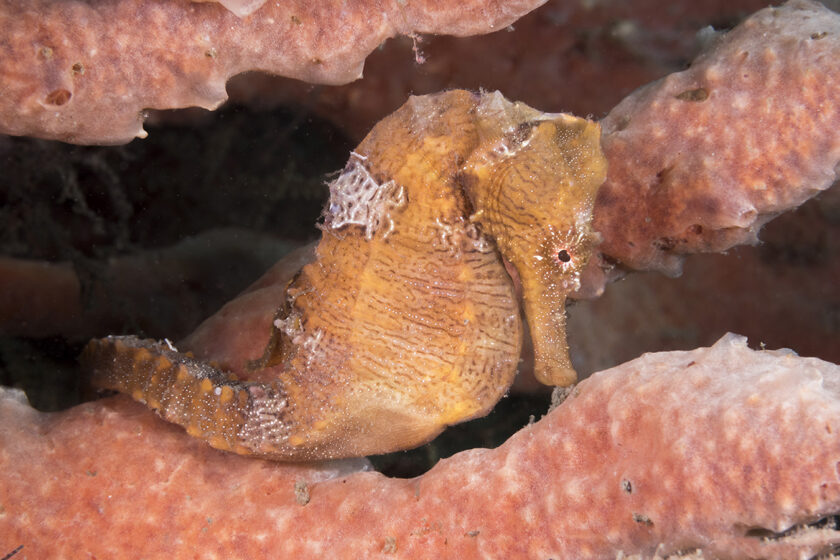West Palm Beach’s Blue Heron Bridge is more than an easy spot for a shore dive, it’s also one the hottest spots for finding an incomparable array of weird-and-wonderful assortment of marine life.
The dive was not going as planned. Fifteen minutes of meticulously scanning the bottom yielded a few interesting subjects like a male pike blenny taking on a territorial stance with its dorsal fin fully erect, and its brilliant neon blue lined throat pouch extended. But this was not what I had come for this day.
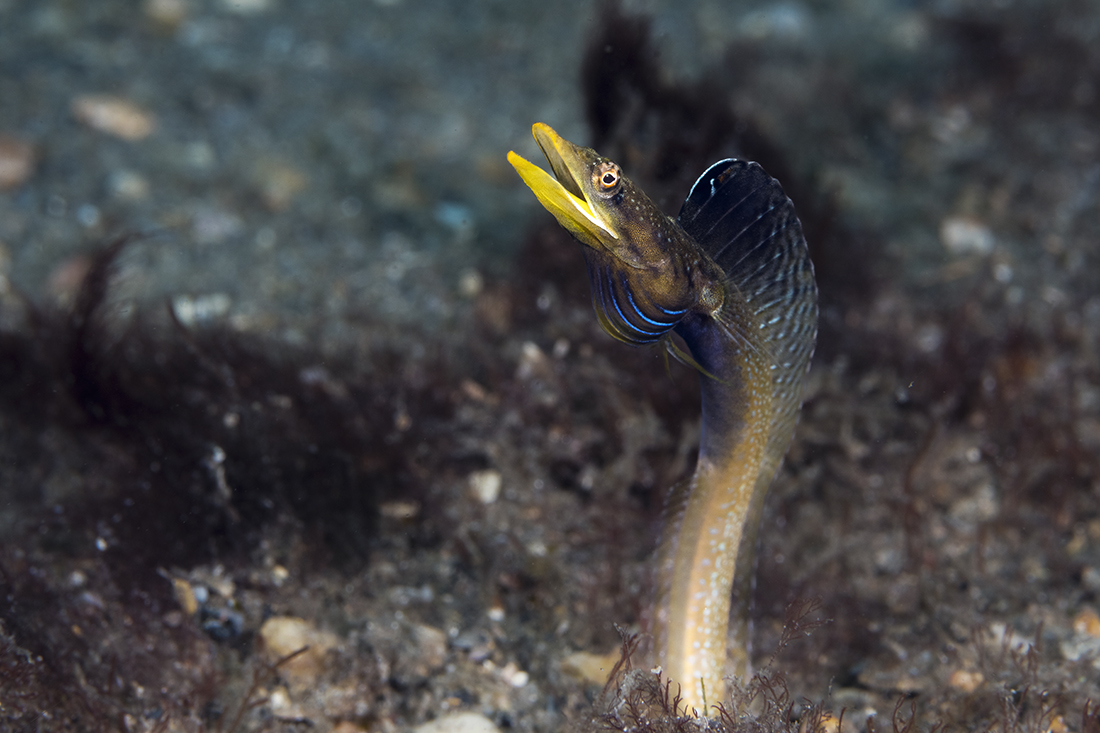
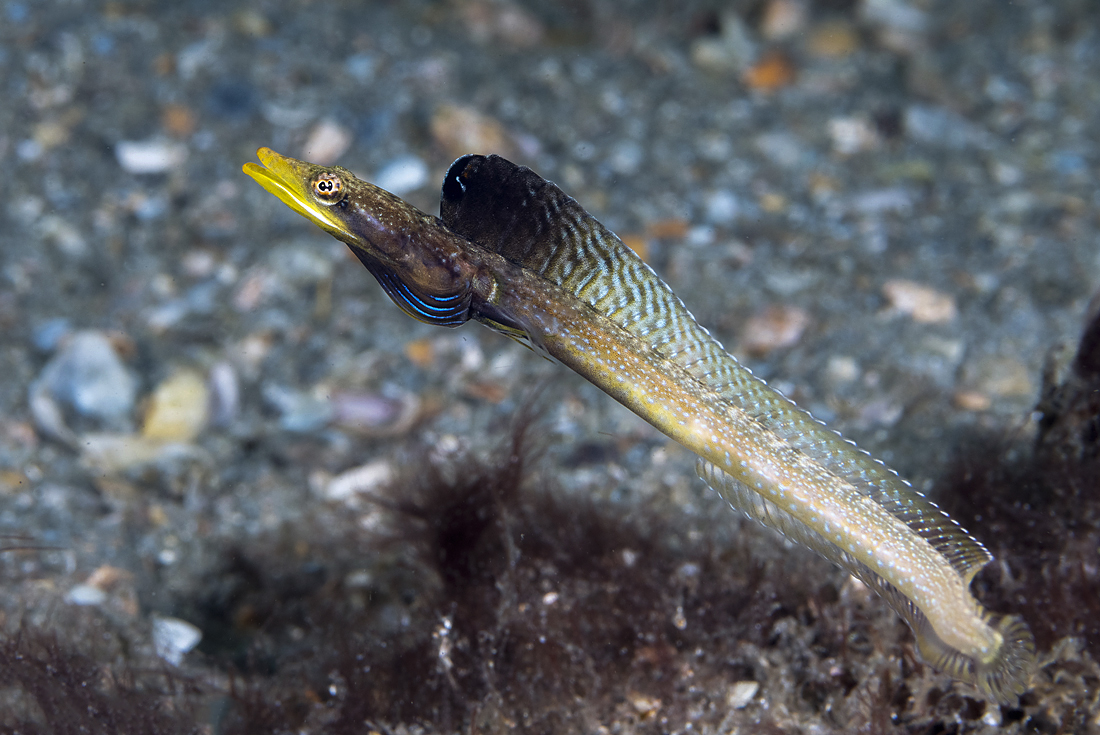
I was on the hunt for another beauty; a striated frogfish (Antennarius striatus).
A member of the anglerfish family, striated frogfish display a variable range of colors from greenish gray, tan, brown to black, to even a few different shades of yellow and orange. In addition to elongated blotches and stripes running across the body —hence the name—there is the “hairy factor.” These fish are generally covered with numerous filaments and tabs across head, body and fins, which gives rise to their other name: the hairy frogfish. In short, I am hunting for a little lumpy-shaped fish smaller than my fist that looks like its dressed in a ghillie suit typically in greenish gray, tan, brown to even black, and on occasion muted shades of yellow to orange.
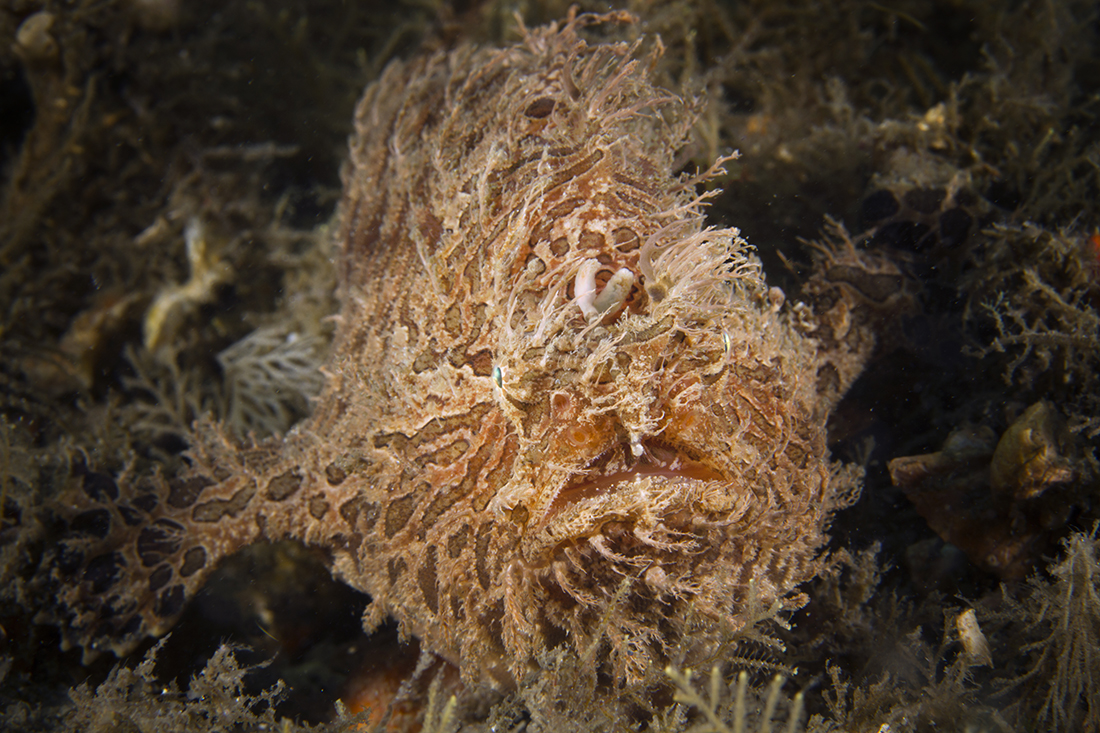
Calling a hairy frogfish beautiful, or even handsome, is a bit of a stretch, but, their cute factor is hard to ignore. Funnier still, is that striated frogfish are not particularly rare species around West Palm Beach’s Blue Heron Bridge. The problem is, they are gifted with superb camouflaging – thanks to nature providing them a Ghillie suit that helps them blend almost seamlessly into the background.
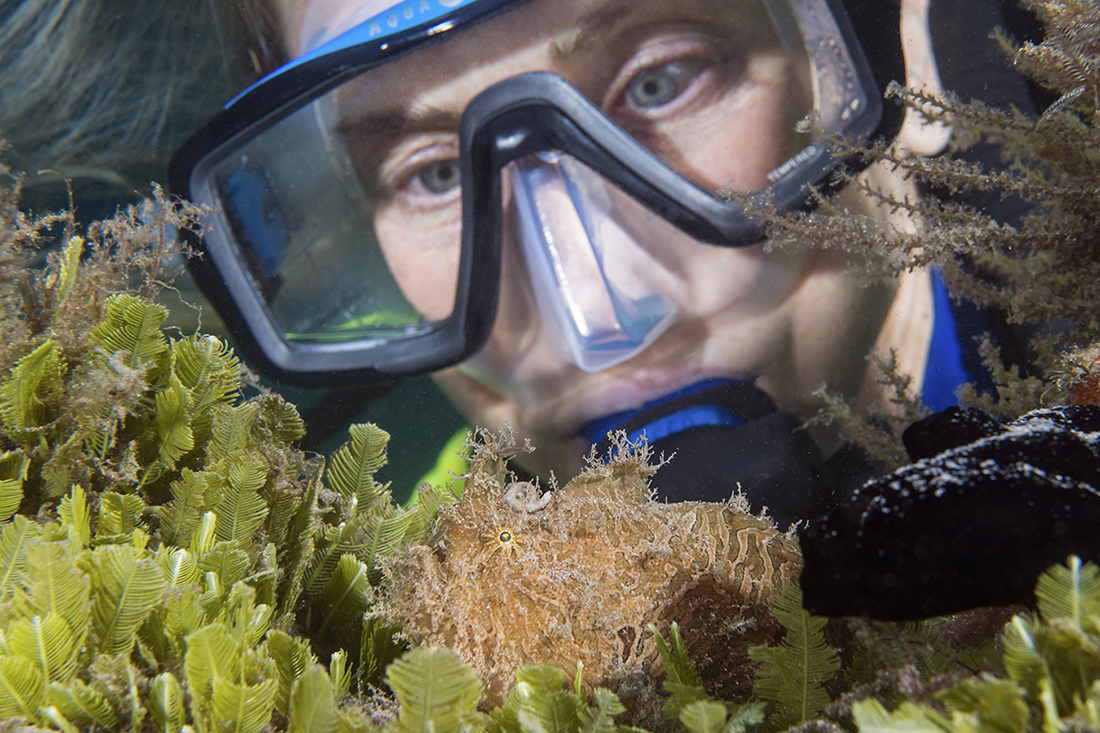
But for a diver with a keen eye, sometimes all it takes is spotting one in the act of fishing or giving a big yawn. Like other members of the anglerfish family, the hairy frogfish has a small appendage on their forehead that resembles a worm on the end of a small rod. If you can spot that lure, the jig is up.
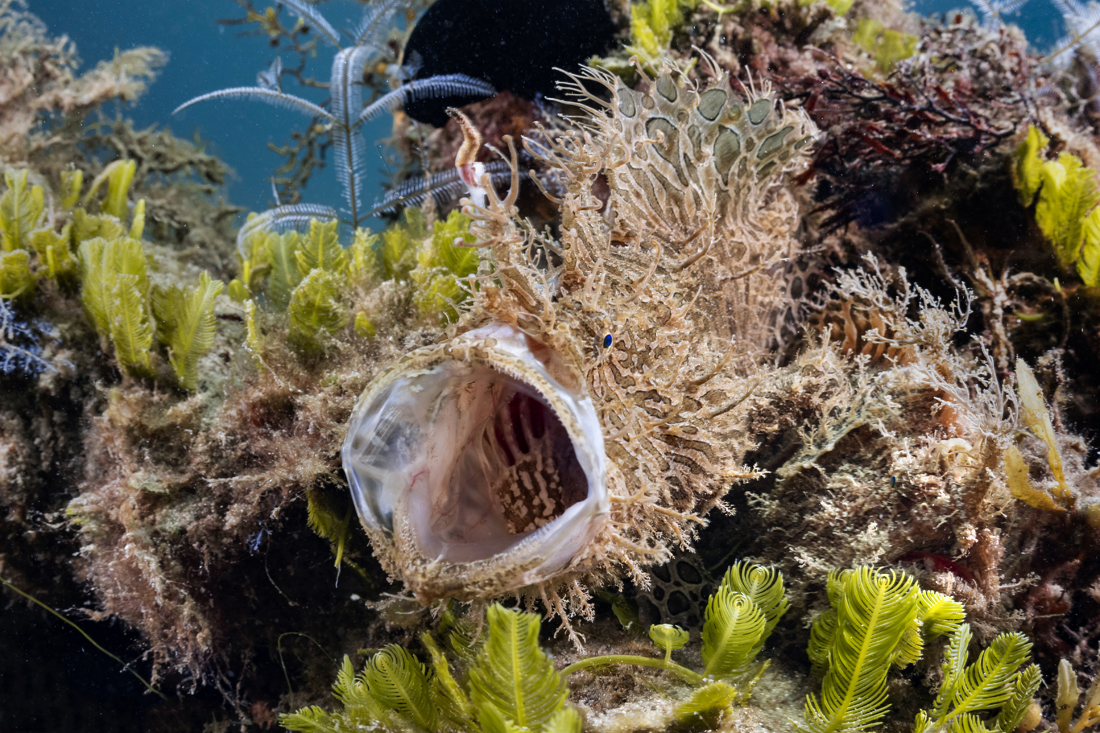
The other way they will reveal their presence is when the lure draws in a potential meal, at which point the frogfish will make a huge yawning burp that sucks the prey into a gaping mouth. It was one of these big burps that not only revealed one frogfish to me, but also his adjacent buddy. Sorry fellows. You are about to be Paparazzied!
Not much for Scenery, but the locals are awesome!
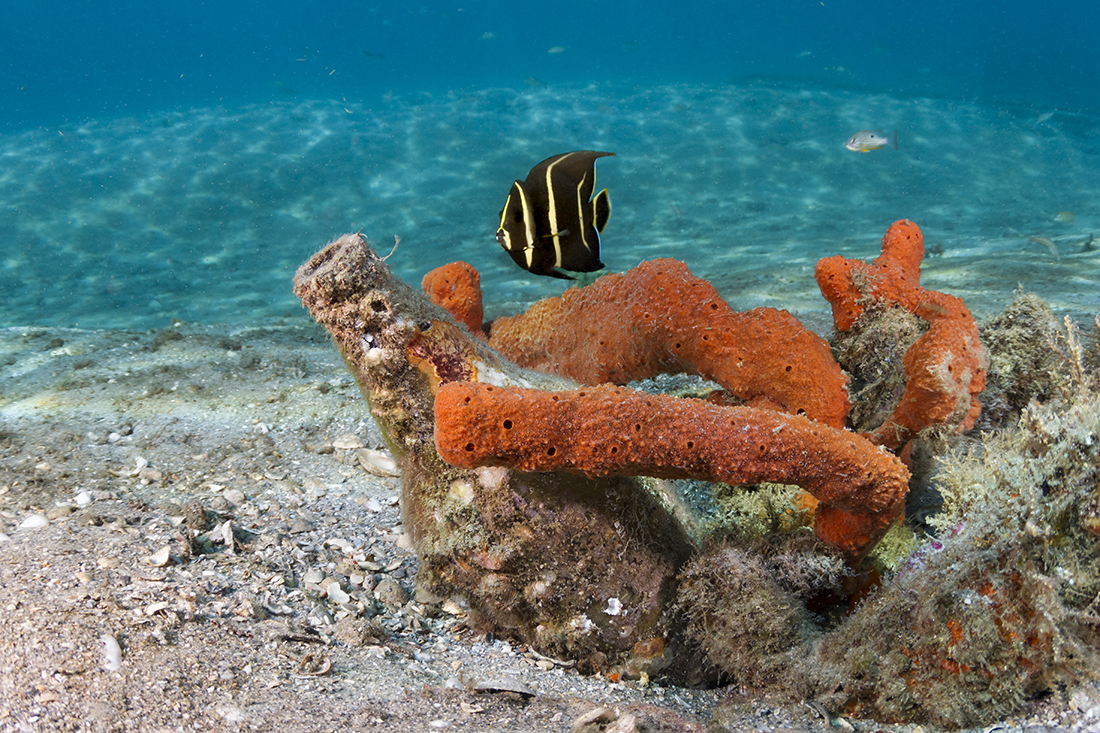
As a Palm Beach resident, I can affirm that to really enjoy diving the Blue Heron Bridge is to understand it. The aquatic treasures that await can be rewarding, but finding them can be challenging, and will require a bit of finesse, as the bottom is comprised largely of sand and silt, which can easily get stirred up. To the untrained eye, this ‘mucky’ type of bottom will appear deceptively lifeless. Then you might happen on something that makes you think you are seeing things, like a rather macabre face in the sand that’s looking back up at you. It’s probably a Northern stargazer. Bottom-dwelling predators in this region rely on camouflage to avoid advertising their position as they lay in wait to ambush passing prey.
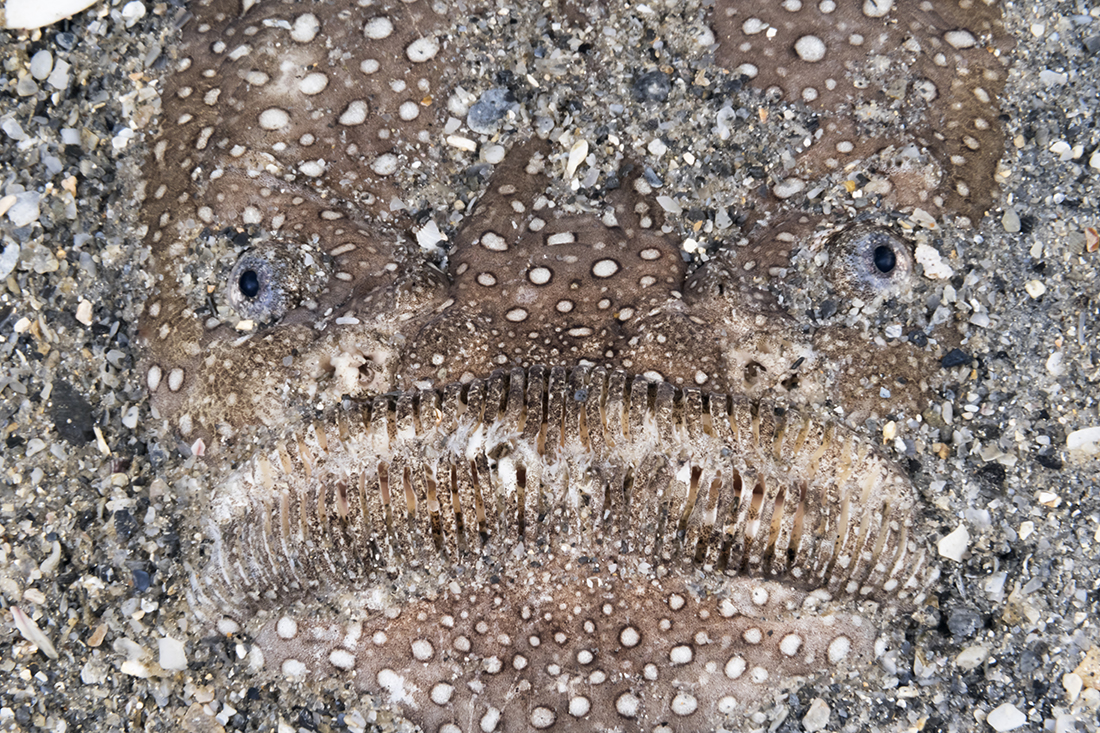
As you move about, further discovery among the sand and rubble reveals more signs of life. Elements such as the occasional empty bottle provide shelter for small octopus or blenny. And then there are the rock piles. In 2012, the city of Riviera Beach placed more than 600 tons of Anastasia rock boulders in varying sized piles 25 yards out from the beach area at Phil Foster Park, which is the starting point for Blue Heron Bridge diving. Created as snorkeling trail spanning some 250 yards long in the 6 to 8-foot deep shallows, these structures give divers who are less interested in scouring sand bottom an alternative, as the rocks host a bevy of fish and invertebrate life. Several years later, the snorkel trail was expanded with the placement of several artificial reef modules. Adding more interest are a pair of small boats that sank at anchor near the bridge. Having been abandoned by their owners right where they sank have become foundations for marine growth and habitat for small fish and invertebrates.
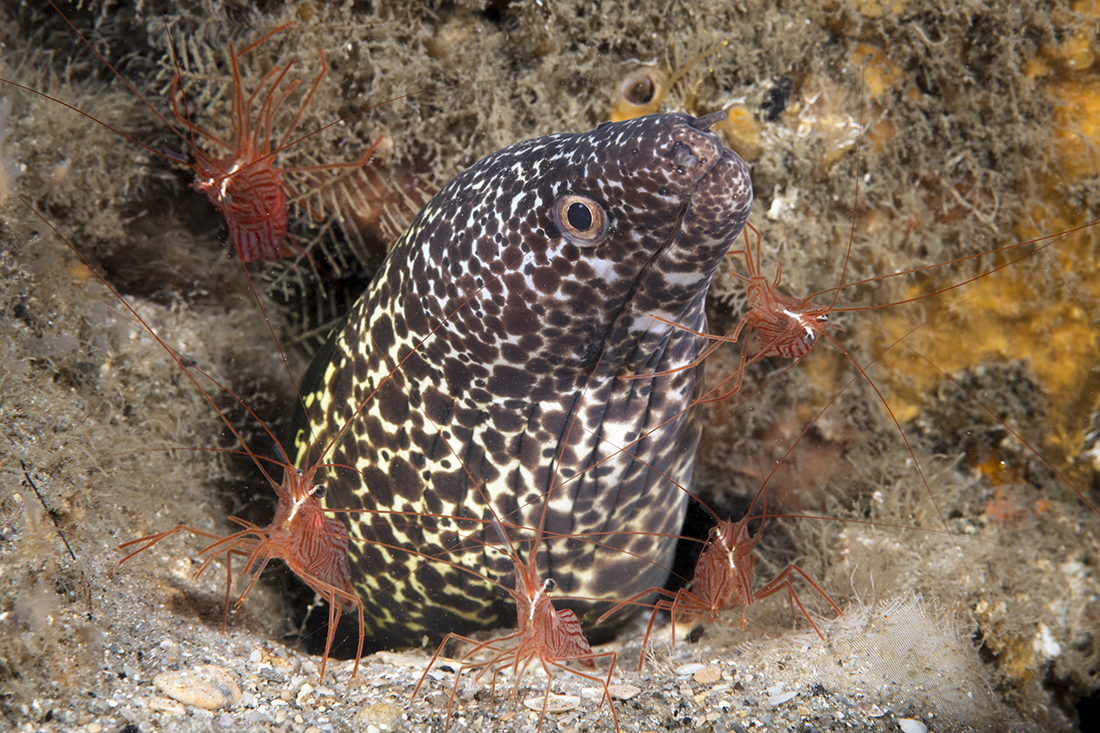
Swimming beneath the bridge that the West Palm mainland to Singer Island creates a completely different diving experience, as the supporting columns are covered in a hodgepodge of brown, pink and orange-hued sponges, along with patches of bright orange cup corals. Here, divers and snorkelers will find a variety of small crustaceans like arrow crabs and banded coral shrimp, while schools of grunts, immature snapper and spadefish move about feeding in the current.
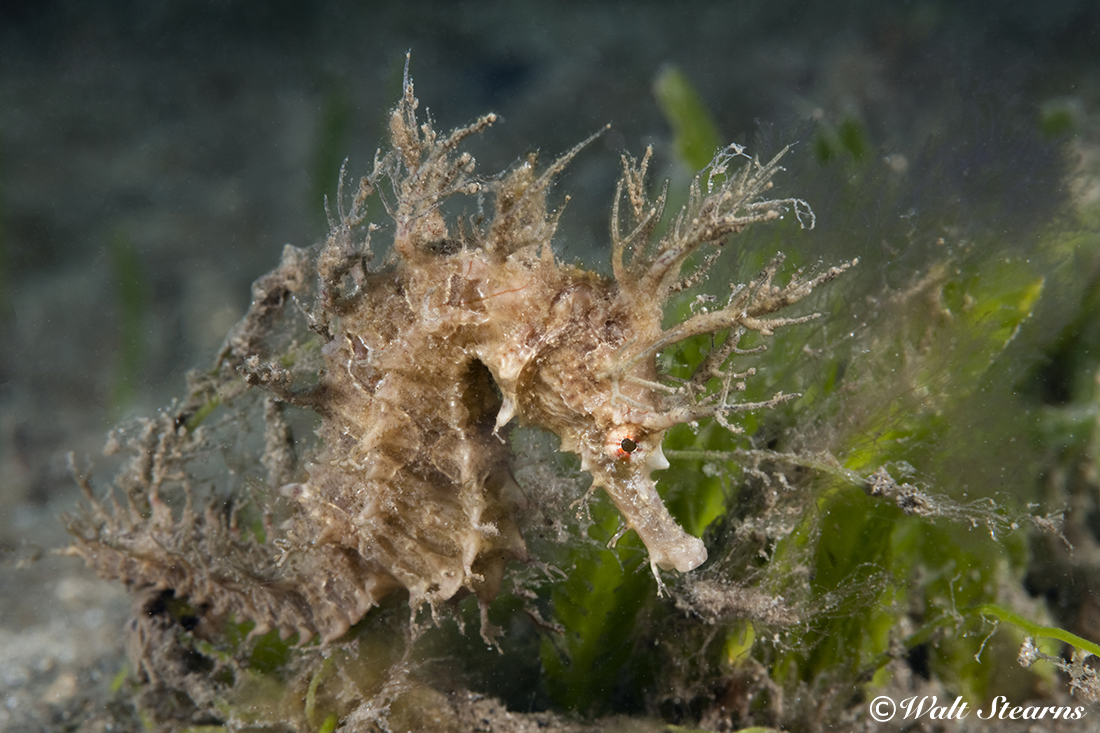
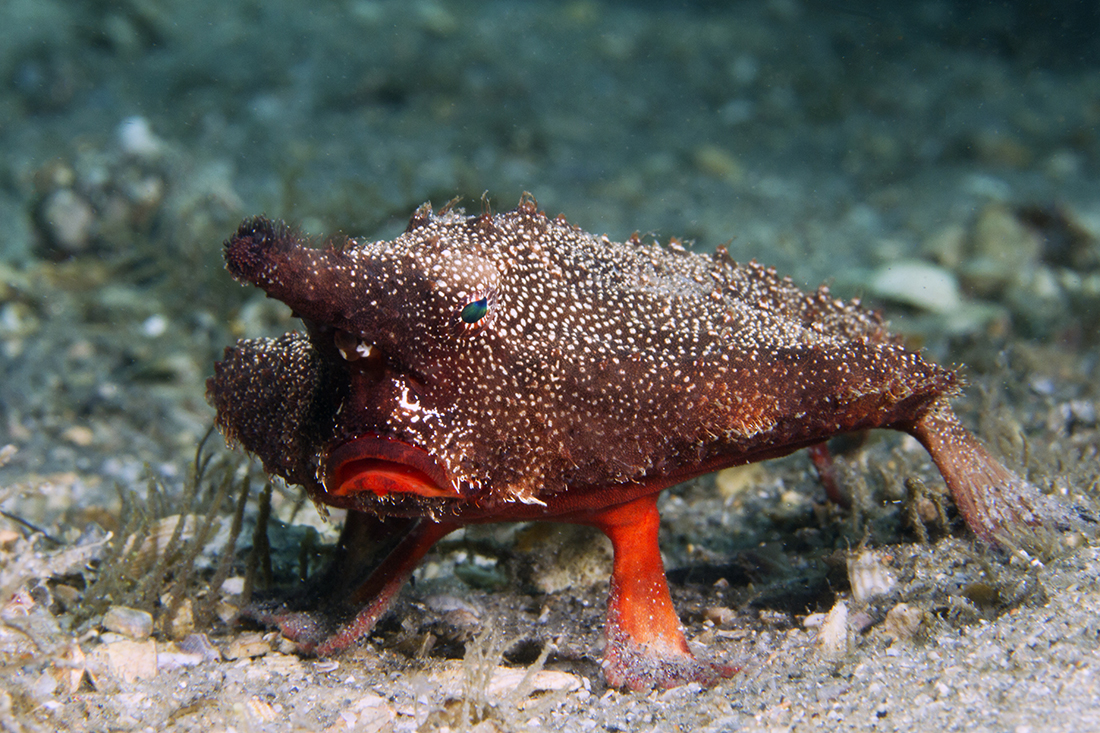
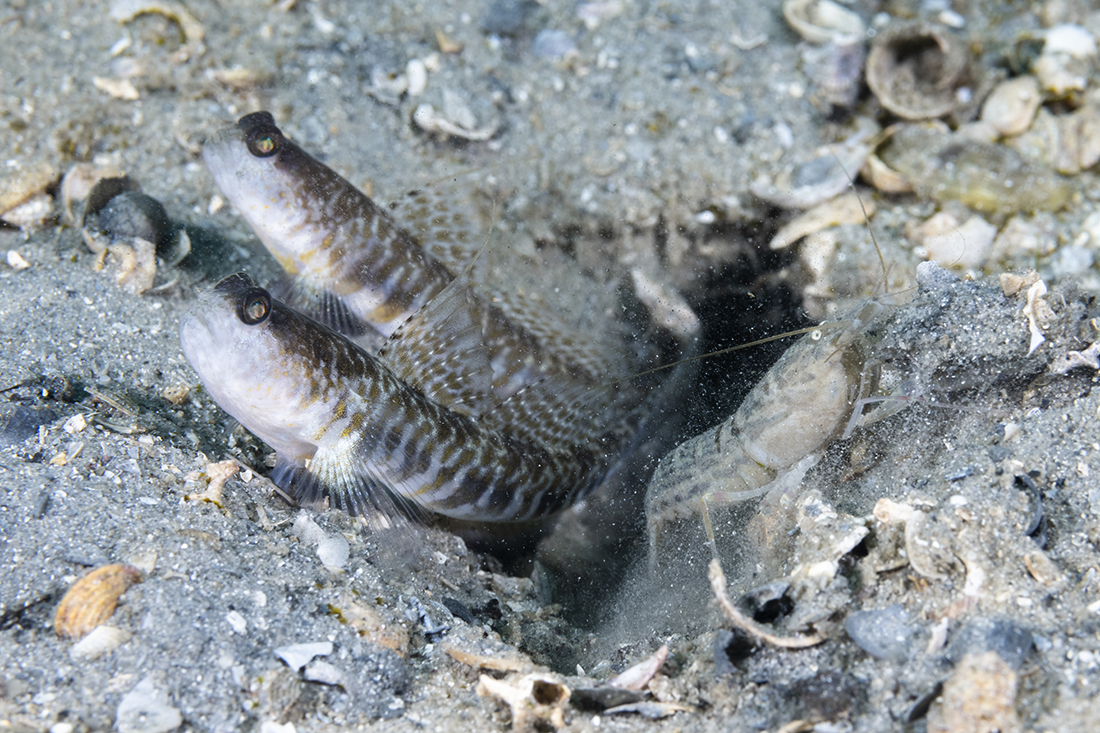
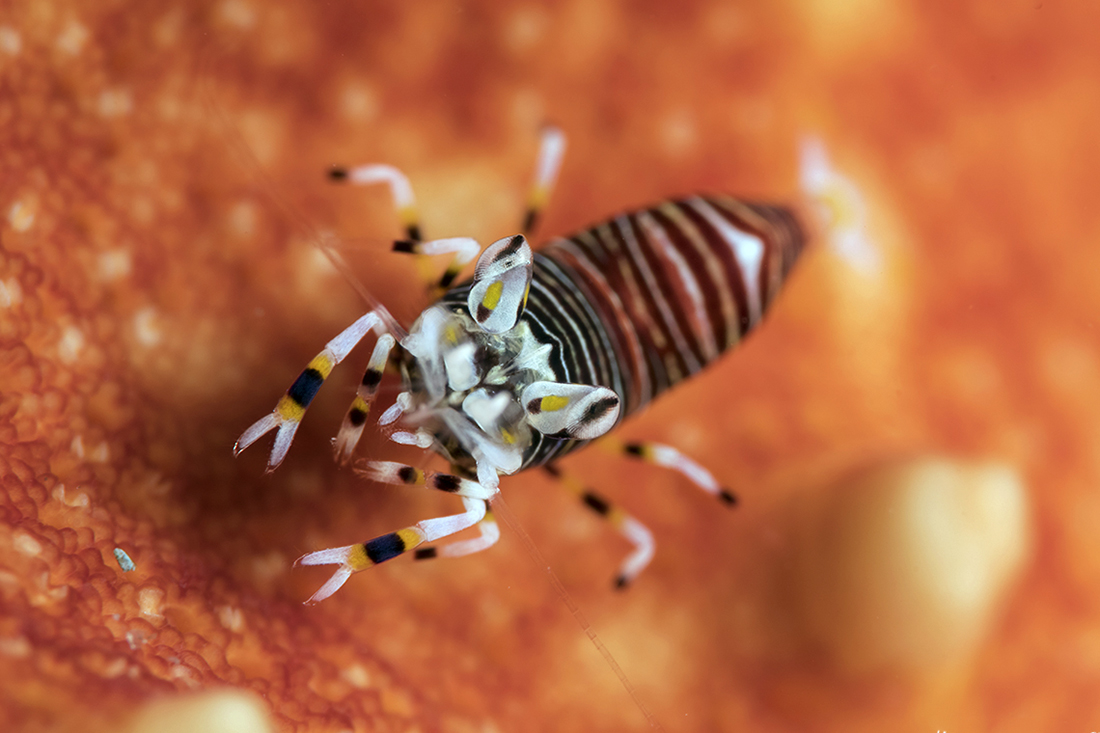
Taken together, the varying microcosms hold a staggering list of fish and invertebrates. Paul Humann and Ned Deloach’s Reef Creature Identification book for Florida, Caribbean and the Bahamas lists approximately 49 species of nudibranchs and sea slugs. Not only have a large portion of these listed species been found here at Blue Heron Bridge, several have only been seen here. It is for all these reasons that the Blue Heron Bridge is a big draw to underwater macro photographers, to the point of it being regarded as one of the tropical Atlantic’s top-shelf muck diving destinations.
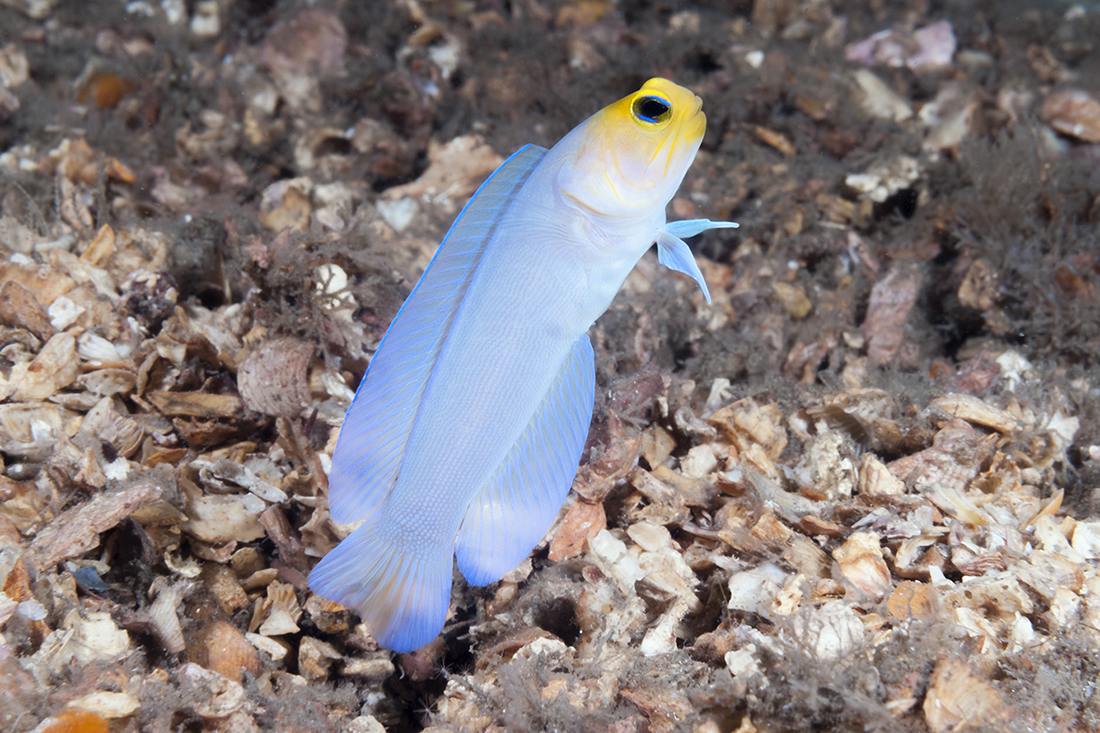
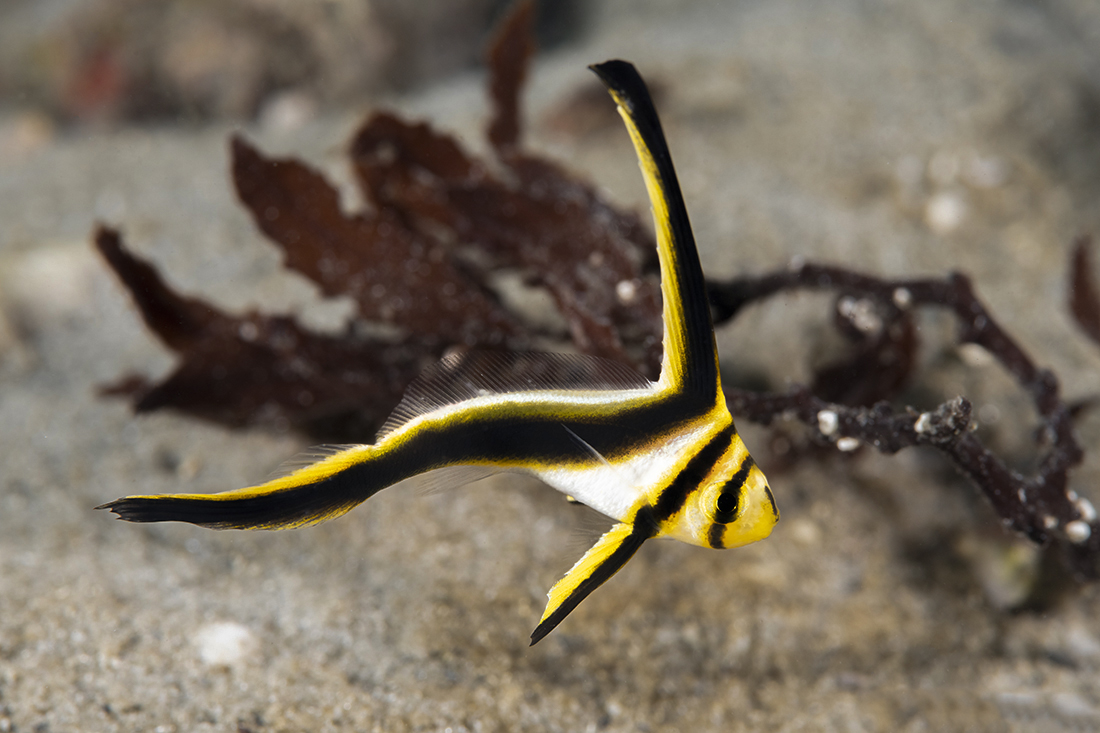
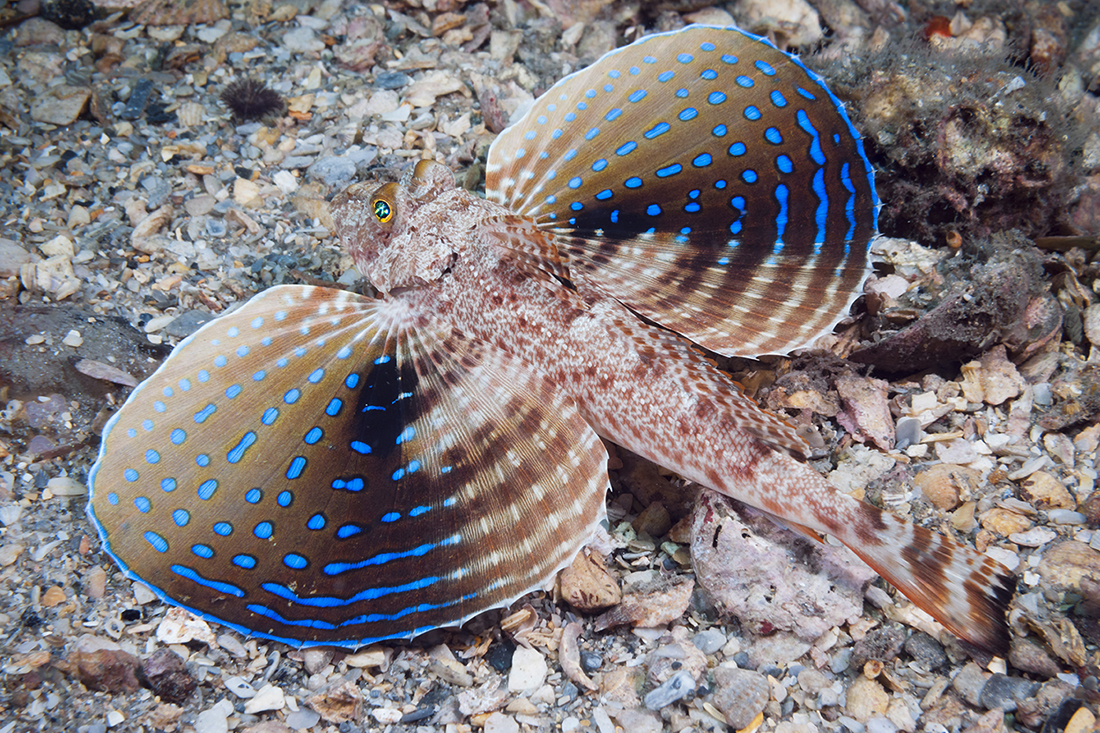
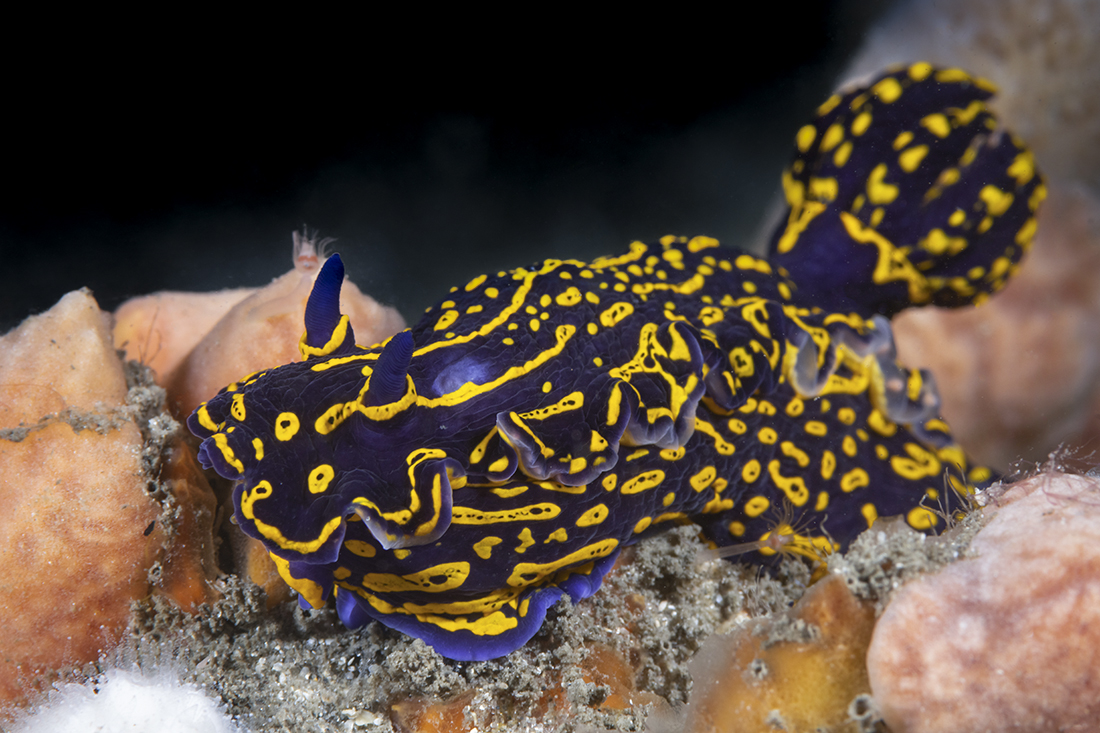
For the same reasons, the bridge has long attracted home aquarium owners and commercial tropical fish collectors, who capitalized on the bridge’s easy shore access. Fortunately, fish collecting was put to a stop recently when, after hearing public outcry from Palm Beach County’s diving community, the Florida Fish & Wildlife Conservation (FWC) Commission passed a ruling (that went into effect back in April 1st, 2019) making the bridge area a protected zone. In doing so, the collection and possession of marine life is prohibited within the park and surrounding waters. The only activity currently not prohibited is recreational hook-and-line fishing from the fishing pier that was the original Blue Heron Bridge.
As a Palm Beach resident and frequent bridge diver, I can attest that the ruling has proven to be more than welcomed move among the local community of underwater macro photographers.
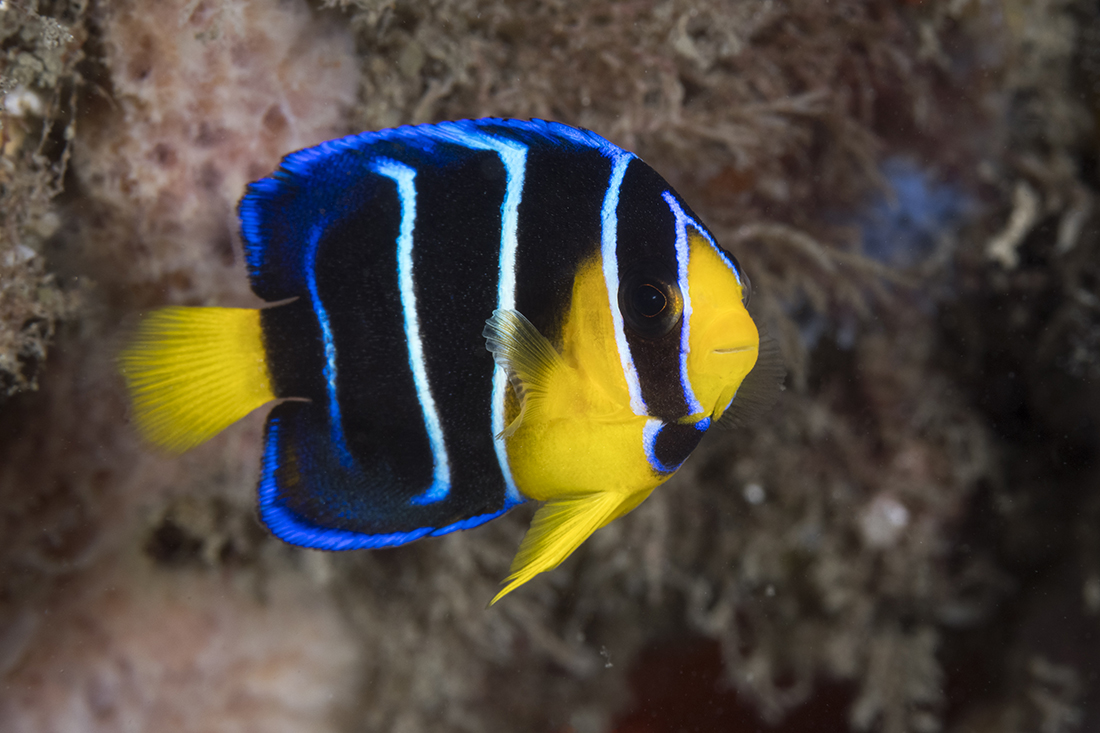
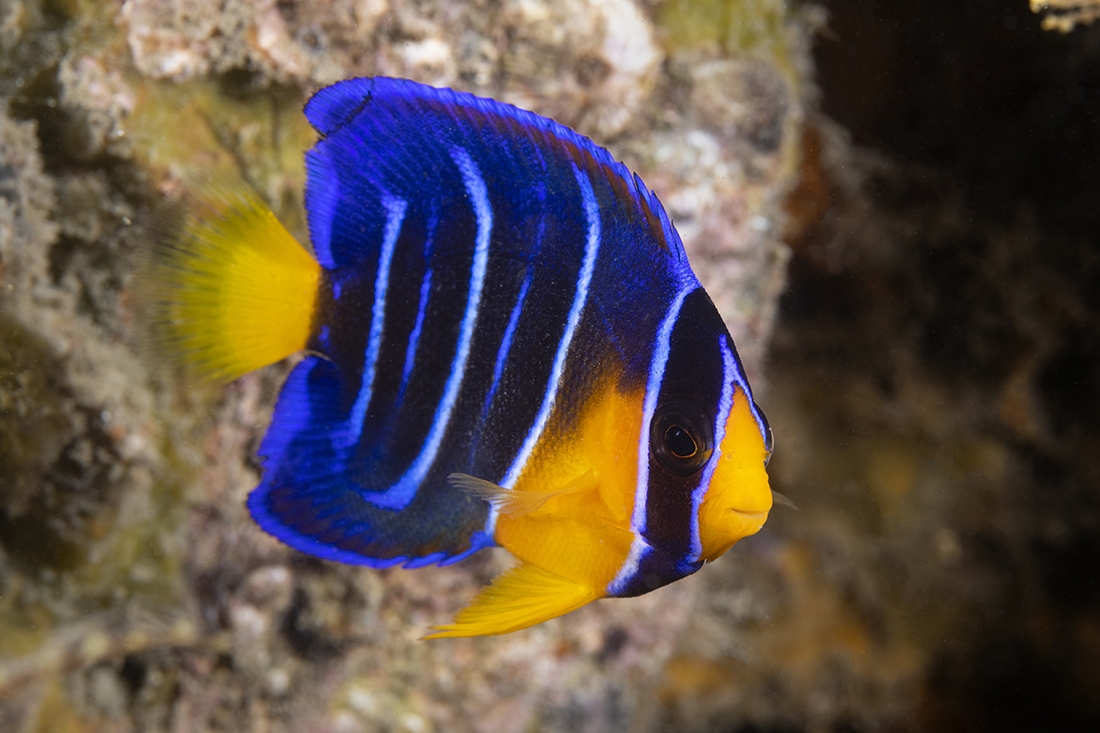
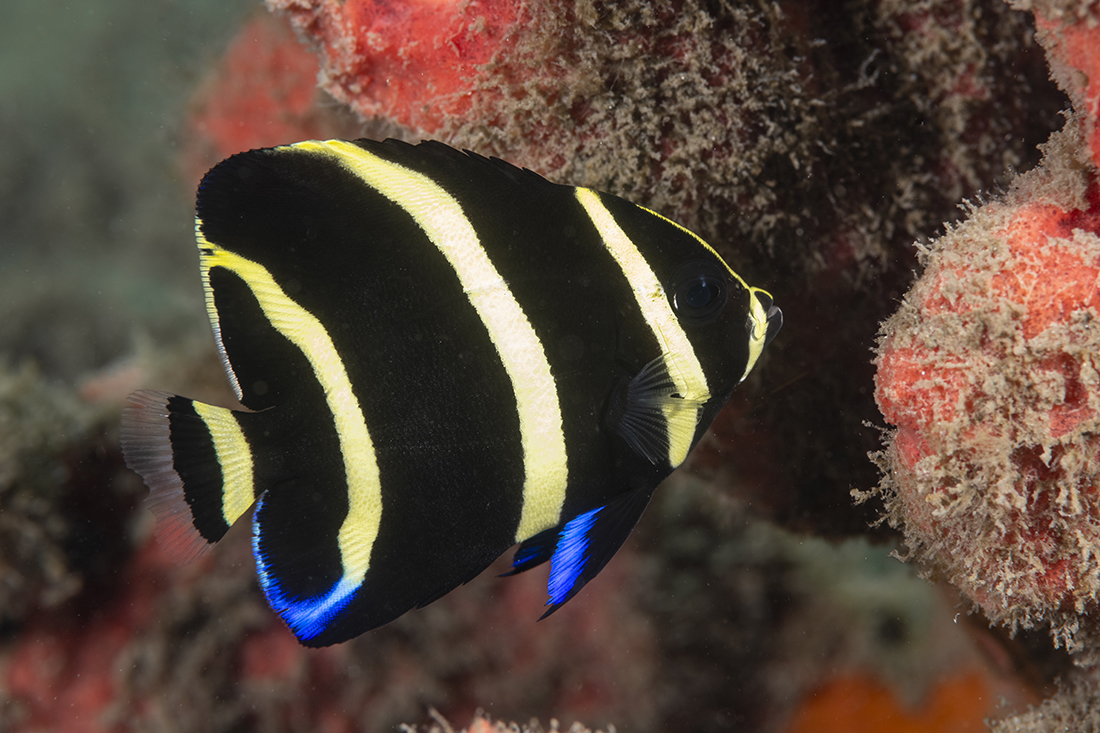
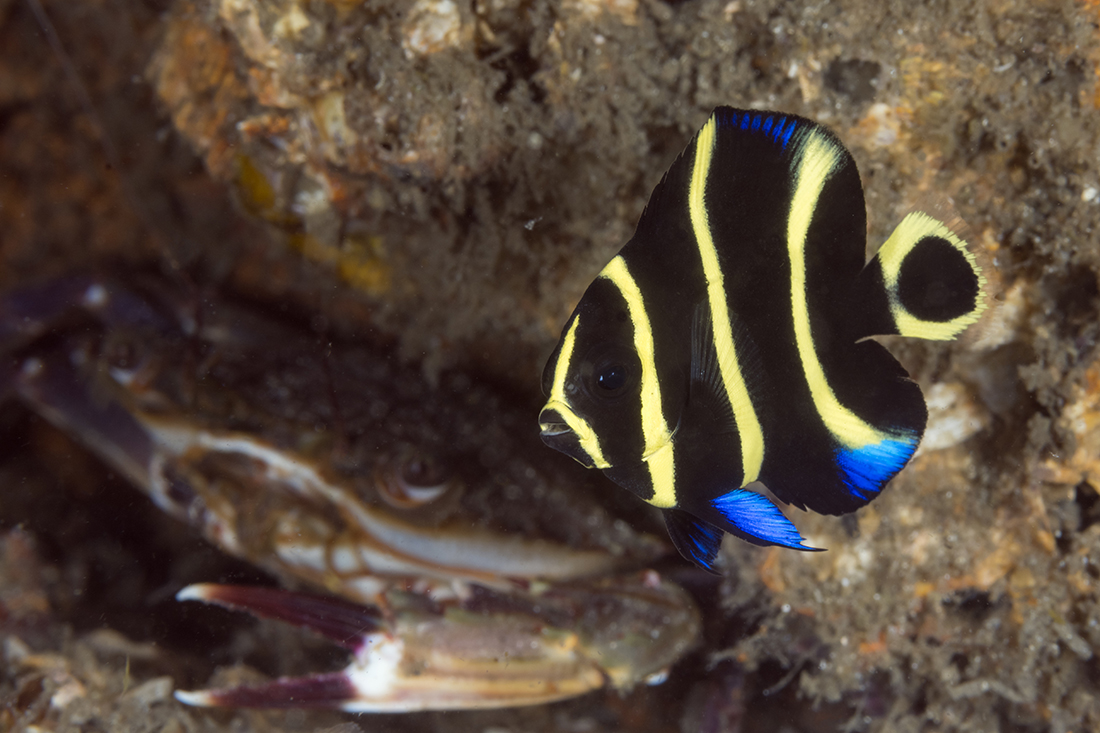
Since the ruling went into effect, success rates on hunts for unique cryptic subjects have gone up. Even more noticeable is the increased presence of juvenile blue, queen, grey French, angelfish, which are found among the bottom’s scattered debris, on lone rock cropping’s and around bridge pilings. Before the new rules at Phil Foster Park were put in place, these little beauties lived with a giant bullseye on the back from the aquarium collectors. Now their numbers have more than doubled.
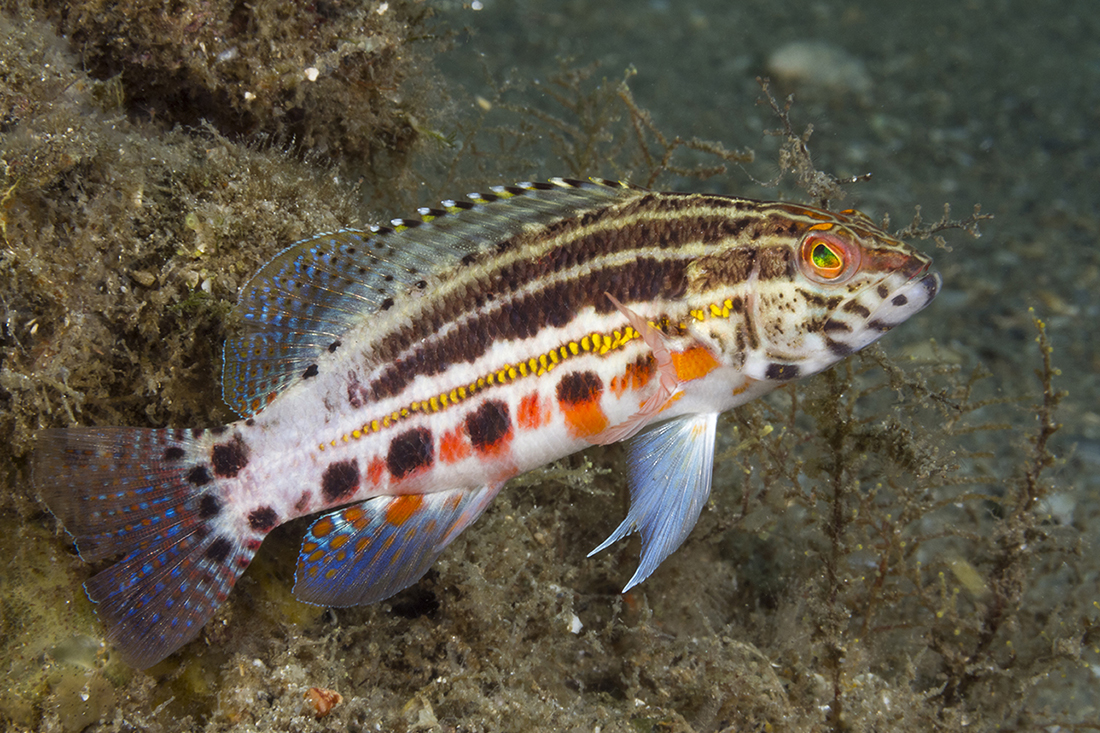
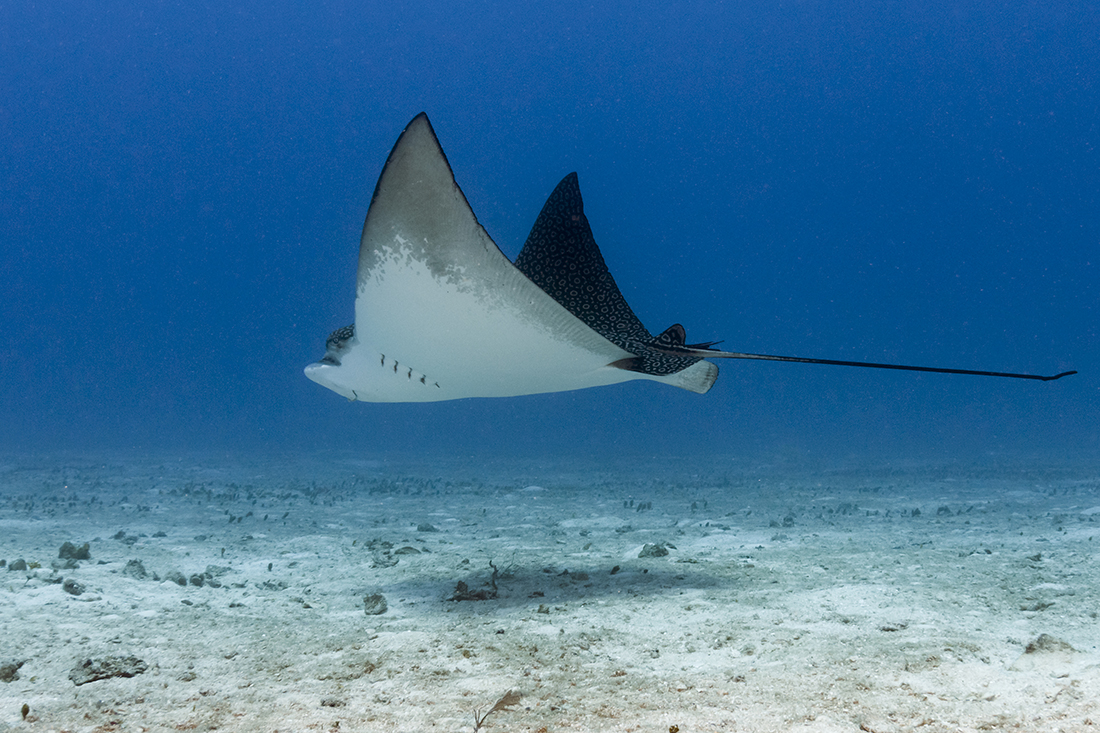
The marine life found on a bridge dive is not limited to the small and unusual. Fortunate snorkelers and divers have been granted with close encounters by passing manatees, and visits from spotted eagle rays. Of late, these graceful fliers have become a more regular sight, with as three or four performing effortless flybys over the heads of unsuspecting macro photographers too heavily involved in getting that shot of yellowhead or dusky jawfish.
What’s that expression? “If you don’t have pictures, it didn’t happen.”
Ins’ and Outs’ of Diving the Bridge – What You Should Know
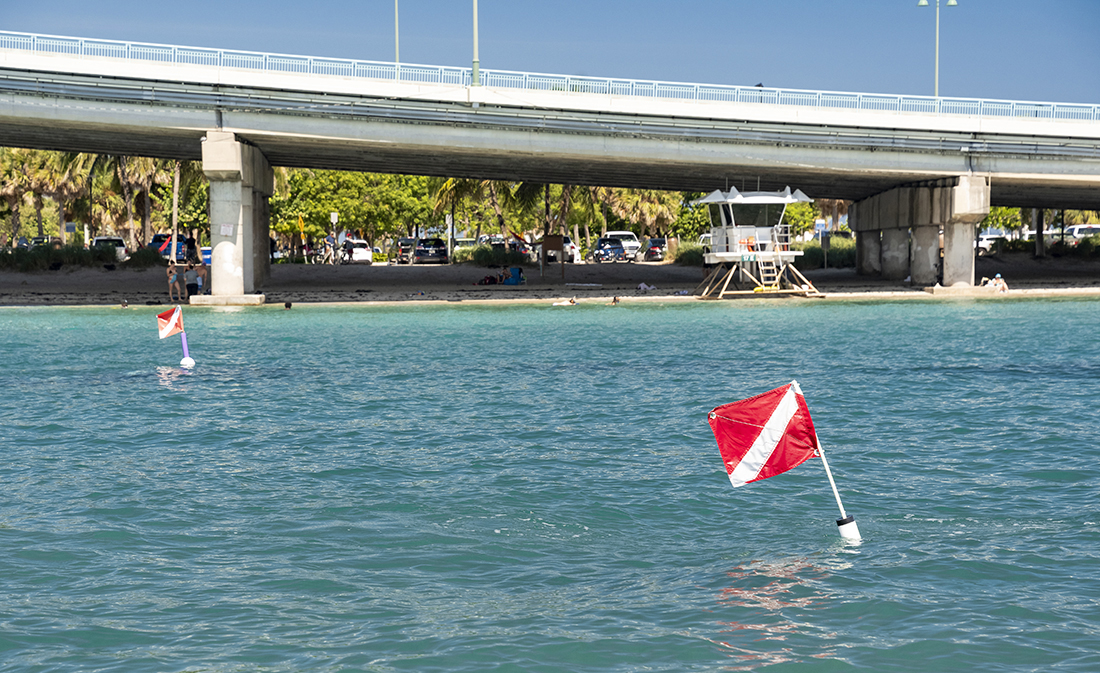
The bridge is part of Blue Heron Boulevard, which connects the city of Riviera Beach with Singer Island. Divers coming from the north or south on I-95 should take exit 76 for Blue Heron Boulevard and head east and over the first (larger) span of the bridge over the Intracoastal Waterway. On the backside of the larger span is a lighted intersection where drivers will make a left turn to the entrance for Phil Foster Park.
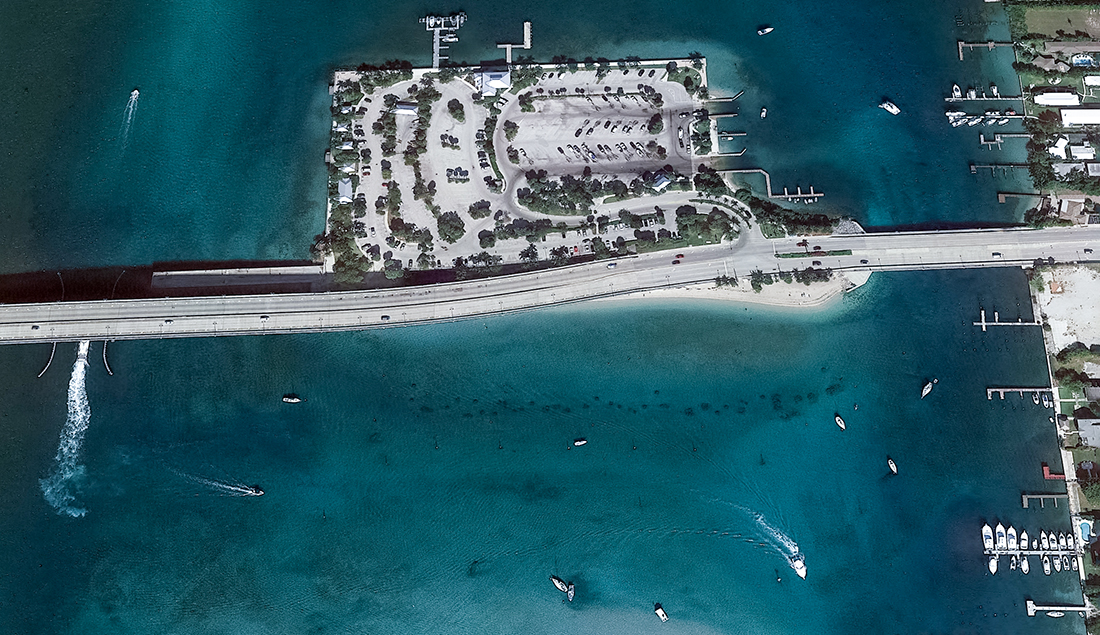
The park is a small island comprised largely of a parking lot with a boat ramp and docks on the north side, and a small beach on the south side. The most convenient spots for accessing the water are along the base of the bridge’s larger span, which is on the southwestern side of the Park.
While parking is free, getting the choicest spot close to the water is a first-come, first-served thing. I can stress the importance of getting there well ahead of your planned dive on weekends and holidays, as the increased number of general beach goers can make finding prime parking more challenging. The entire diveable area of the Blue Heron Bridge is large enough to make it impractical to attempt to cover it from end to end in the span of one dive. From a logistical standpoint, the bridge can be divided into three zones.
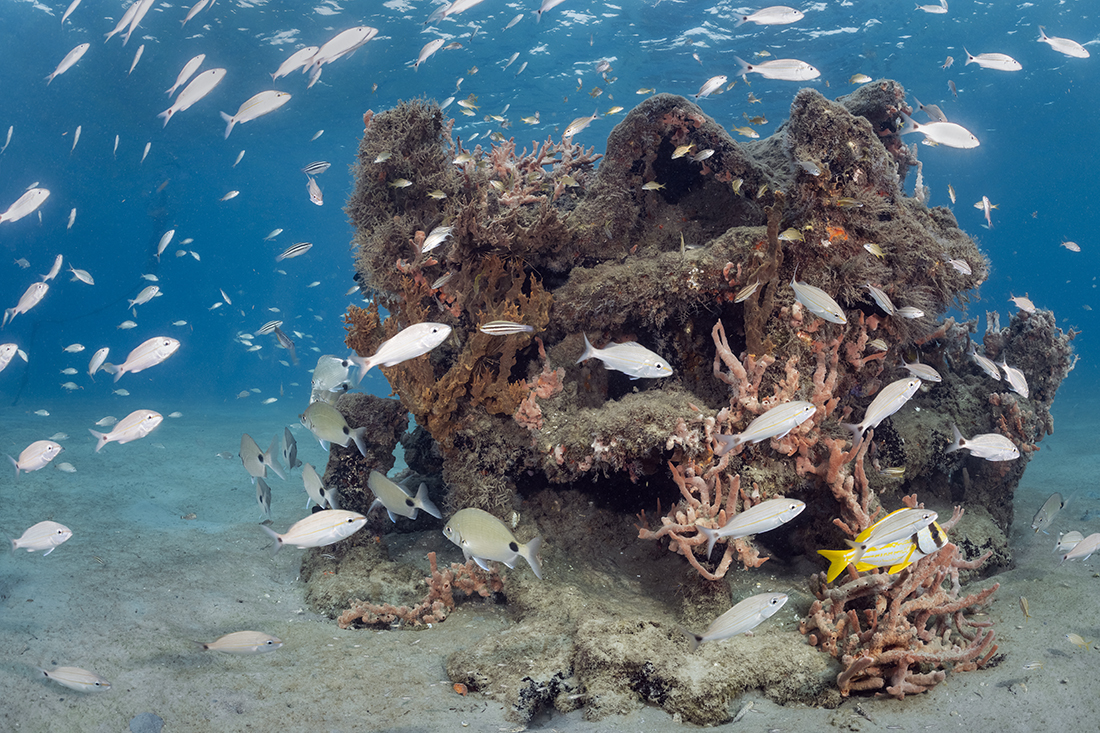
The first zone covers region in the shadow of the larger span from the entry point towards the center point of the bridge. This area also includes a section of the original Blue Heron Bridge, which now serves as local fishing pier. Zone two is the area out front of the beach, which is all flat sand bottom with small grass beds before meeting the Phil Foster Park Snorkeling Trail 25-yards out.
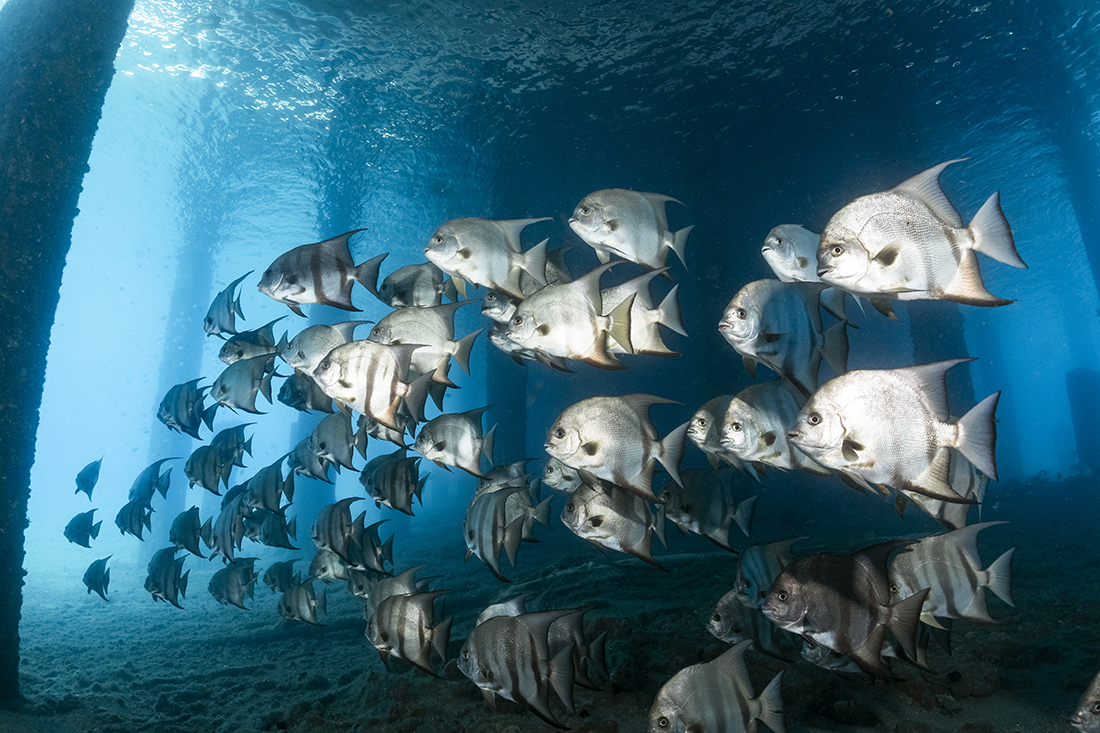
To the east towards the small bridge span connecting Phil Foster Park with Singer Island is third and final zone. This smaller bridge generally has more growth on the pilings than the larger bridge, and it also features the two boat wrecks. Nearby, on the farther side of this zone towards Singer Island is a large defunct boat dock where a forest of growth covered vertical standing pilings harbor an assortment of small marine life.
Timing is Everything
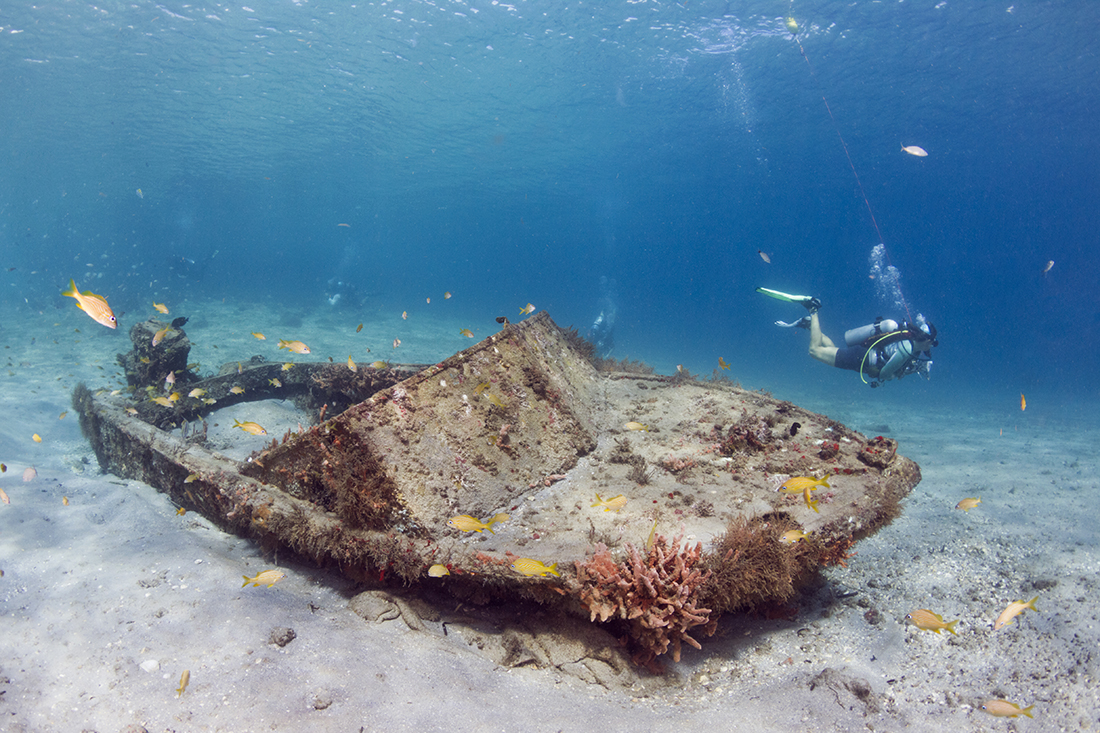
During most hours of the day, the waters around the foot of West Palm Beach’s Blue Heron Bridge won’t look very enticing, having a muddy-brown hue that is typical for most of Florida’s Intracoastal Waterway. When these conditions prevail, underwater visibility is better measured in inches rather than feet. But, when the incoming tide starts to pour through the Lake Worth Inlet, a transformation takes place and the water becomes clearer and far more inviting. This tide change is the engine that drives the abundance and diversity of marine life found around the bridge, while also providing the best visual window of opportunity. During the final two hours before the peak of the high tide mark, underwater visibility can jump as high as 40 to 50 feet, while on most days 15 to 30 feet is more of the norm.
To know exactly when that is will require consulting the local tide chart for the Port of Palm Beach (http://tidesandcurrents.noaa.gov/noaatidepredictions/NOAATidesFacade.jsp?Stationid=8722588.)
Diving anywhere within these three areas could not be easier as the depths never exceed 18 feet, but there are a few important things to consider. During the middle phase of the rising tide, it is wise to hold off venturing around the bridge’s pilings under either span as the current can be quite strong. The best time for diving around the bridge pilings is half an hour before the apex of the rising tide, when the current is easier to handle. Timed right, you will be able to enjoy an additional half hour almost current-free before conditions change as the tide reverses course, bringing with it the dirtier waters of the Intracoastal Waterway.
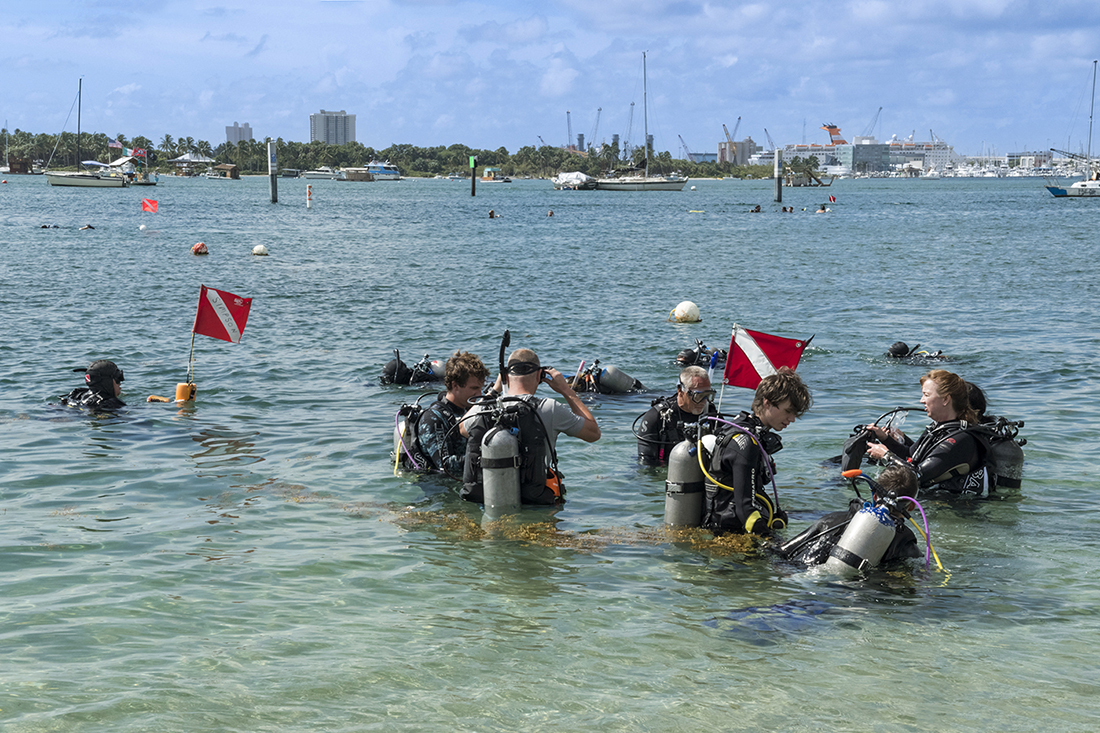
For a good tipoff for when that change begins, watch the local scuba instructors who favor Phil Foster Park as the cheap seats for introducing their students to their first ‘ocean dive’. When they begin herding their students to the water, it’s time to submerge. When diving any park of Blue Hereon Bridge, park rules require you to deploy a dive flag on a float. If not, the authorities might hand you a ticket for not complying.
Night Diving the Bridge
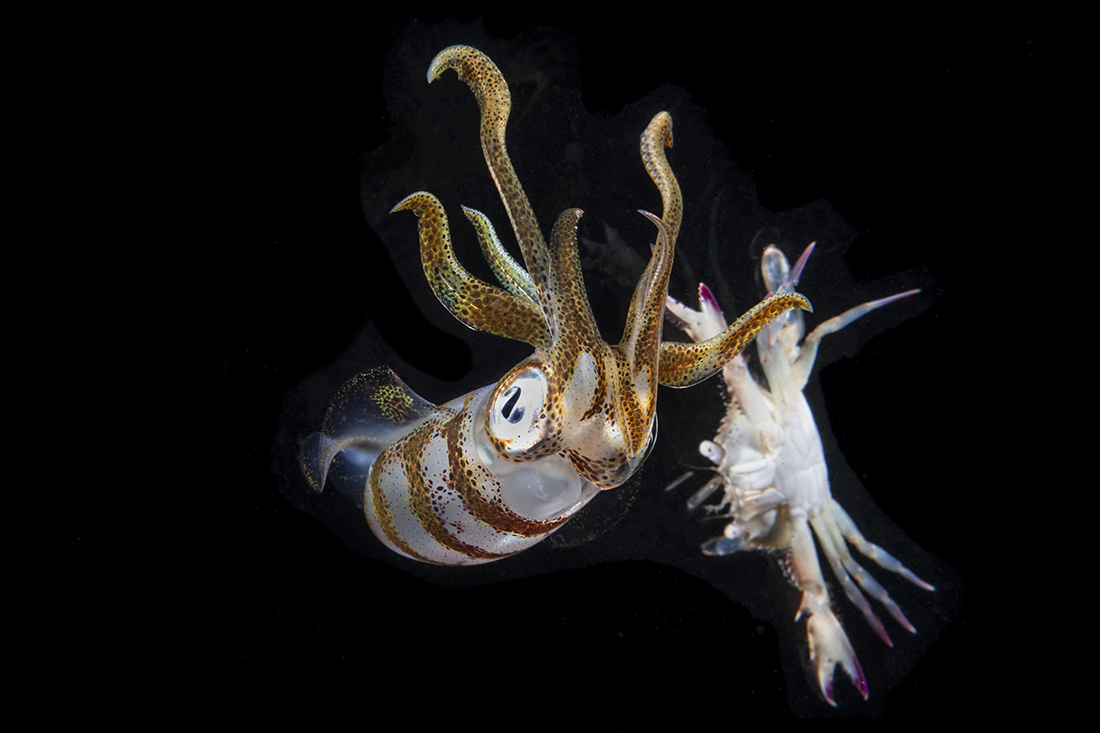
Although the Phil Foster Park is generally open from sunrise to sunset, night diving is allowed through special arrangements with some of the dive operators in the Riviera Beach/Singer Island area. Should you become a fan of bridge during the day, coming back at night is something worth looking into. When the sun goes down, so begins the hour of the night beasts. Octopus and mantis shrimp emerge from their burrows and dens to forage for food. This is also when reef squid hang in the shadow of a diver’s lights, ready to snatch small unsuspecting fish or shrimp exposed by the illumination.
For night diving opportunities, inquire with the nearby local dive centers like Force-E in Riviera Beach or Pura Vida Divers, as it is the City of Riviera Beach now requires divers to register first with those participating centers to get a one-time parking permit. For the nights night diving is allowed to take place, time in the park cannot exceed 10 pm, after which time divers should be out the water and exiting the park. Compounding this a little further, should high tide take place well after that time, shops will not issue a permit for those nights.
It is on this note that I conclude my overview of the Blue Heron Bridge. Be sure to have a look at my overview of the region’s collection of highly distinctive wrecks and reefs to get a more complete picture at to what this part of Florida’s Southeast has to offer.

